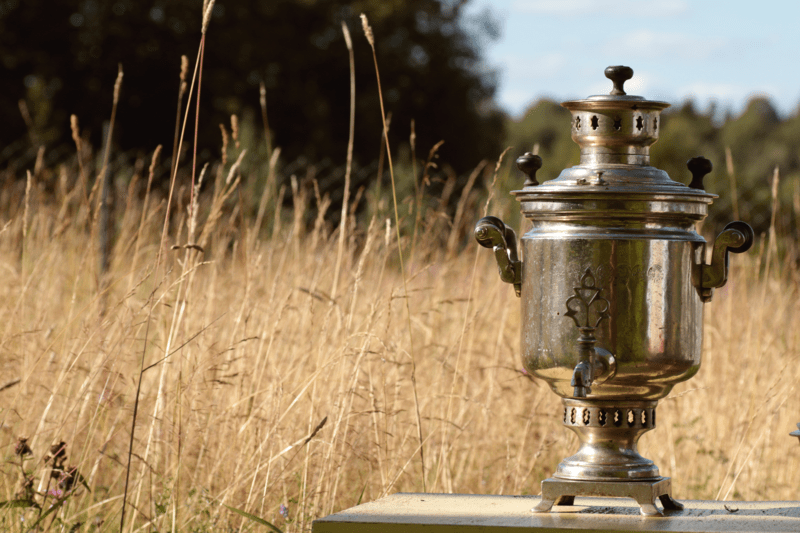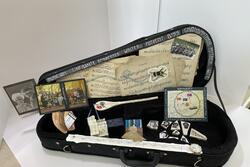My Samovar: A Connection to Soviet Jewry
It looks like a cross between an antique jug and a basement boiler. Scrollwork, crude filigree, and a massive spigot decorate its dented brass cylindrical body, and it stands on a thick, square foot. It’s an obsolete, non-American object. In Russian, its name means, “self-boiler.” Give up yet? I’m talking about my samovar.
The samovar was an essential household appliance in nineteenth-century Russia. Usually, it had an urn-shaped tank with a chimney in the middle and a burner on top. Coals in the chimney heated the water in the surrounding tank, along with a small teapot on the burner. The teapot held a few spoonfuls of water that were mixed with tea leaves and other magical ingredients to create a potent elixir. Tea-drinkers poured a small amount of this steamy slurry into a teacup or glass, then filled their cups with hot water from the samovar’s spigot. The comfort and peace of richly-flavored tea ensued. It was the staple drink of nineteenth-century Russia, like coffee in America today.
The samovar was so important to my Russian-Jewish ancestors that they brought it with them all the way from modern-day Belarus to the east side of Cleveland. Their immigration was as alike and as different as thousands of other Jewish immigration stories in terms of timing, destinations, family separations, and stops in between. My great-grandfather, David, came first, sailing into the port of Halifax, Nova Scotia, in 1910. His wife, Sadie, followed in 1912, bringing with her seven children who ranged in age from one to 20 years old, including my fourteen-year-old grandfather.
The problem is, the samovar weighs 14.5 pounds—as much as a healthy infant. It’s the kind of object you’d pack in a shipping crate if you were moving to another continent. But in the early 1900s, immigrants carried their belongings in baskets and bundles slung over their shoulders. Did they really have samovars in those bundles? How many were carried by women traveling with seven children?
The samovar stayed with the family as they moved from Halifax to Montreal, and from there to Cleveland and Detroit. Presumably, my great-grandmother Sadie used the samovar in all these cities. I imagine how hard it must have been for her to find the right combination of tea leaves and spices in a midwestern storefront grocery. Maybe she heated the samovar with coal, or maybe she sent the children out to find wood chips and pinecones. I wonder when she realized that it was easier to just boil water in a teakettle on the stove.
Mine was a typical immigrant family—short on sentiment, indifferent to religion, and eager to Americanize. Yet after David and Sadie died in 1927 and 1938, someone among their seven children thought it was worthwhile to hold on to the samovar. My own grandfather was far more traditional and religious than the rest, but despite being one of the older children, he was never in possession of the samovar. It passed through the line of the second-to-youngest of the seven children, ending up in the hands of one of my first cousins once removed, another David, named, like my own father, after the patriarch.
I heard about the family samovar for years, and I knew that my father, of blessed memory, resented the fact that it was not in his hands. When my cousin David died suddenly, his son, who has no children, was more than happy to send me the samovar. In the end, I’ve valued it more than any of Sadie and David’s other descendants, and not just because I’ve never been a coffee drinker.
When I first received the samovar, I rubbed its dull surface with a brass cleaner, and it came to gleaming life. The imperial eagle of the Russian Empire is emblazoned on the side. Embossed underneath the eagle is the name of the samovar’s manufacturer, Vasiliy Stepanovicha Batasheva, seemingly the Henry Ford of samovar makers, along with the model year, 1896. All around this trademark, coin-shaped stamps are etched into the brass. They represent excellence-in-design awards, including one from the Chicago World’s Fair.
Despite its fancy engravings and new-found luster, my samovar bears the scars of old age and much travel. The wooden knobs that control the assorted vents are dry and faded, and one has broken off. Corrosion fills the thick seams of the various welded parts. It would take a master metal worker to make the samovar functional again. It’s a bit like my father’s family—old, with missing pieces, greatly altered, but still here.
Like me, countless Jewish women have inherited furniture, linens, china, and silver. Some of these objects are standard American, but many of them are physical reminders of the regions our families left, often under duress. Like my samovar, these objects are not inherently Jewish. Samovars are Russian and in fact, there’s a museum of them in Alaska that reflects that state’s very non-Jewish Russian history. Yet, my samovar connects me to the lost world of Belarusian Jewry. I’ve invested my later years in a search for my Jewish heritage, through music and Yiddish and genealogy, but now I have something tangible to give to my children. Even though it has no religious connotations, the samovar feels like a gateway to my Jewish past.








What a lovely story which I will treasure. My grandmother, Claudia Batasheva was the daughter of Vasiliy Batashev’s brother, Pavel. My cousin in Australia has one of their original samovars.
In our Family they brought the samovar to Argentine !Seeing Marc Chagall's early paintings I could realize that this object had a trascendental meaning for People's existence and coexistence !Congrats to You Beth for this lovely article !
This past summer my uncle showed me the samovar from my grandmother (from Odessa), he had it restored. The inscription, To my children, Pearl & Louis, your father M. Olshanetsky, 1913. This inscription led me to months of searching through census and harassing my father for memories. I discovered his grandmother Pearl immigrated to Philadelphia with her maternal grandparents and 3 other siblings in 1904-What happened to her parents, we can only guess. At this time, I believe that the samovar was a wedding gift sent by her father from Odessa, Russia.
My family has a very similar story with a samovar. Immigrants from Belorus from the beginning of the 20th century. Our samovar even looks very similar to yours. It's from the Tula Factory which I think is somehow related to the Batasheva family.
Thank you so much for writing this up as it makes me appreciate our family samovar more.
Please also allow me to suggest that although the samovar is lovely along with its meaningful tradition, the Jewish heritage is an even more valuable inheritance to be claimed. And it only takes a small step to claim it. Lighting Shabbat candles for example. I don't mean to pressure you, so please if it feels that way, read the first part of my comment which is also completely heartfelt. Thank you.
I now want to exhibit oil paintings by Olga Anyonova of samovars - she has painted them many times - Henoch Gallery NYC shows her work - we will hopefully show the artwork at our shul’s library this Winter! Wonderful story!! Thank you to the author!
My friend has the samovar her Grandmother kept while hiding in the woods. Tea played such an important role in her life (her Grandmother raised her), she started a tea company called The Tea Spot. I loved seeing your story!
Hello Beth,
I have a very similar samovar that my grandmother brought from Belarus and I have photos of it. As you described yours, I pictured mine, with all the accolades stamped on the front of it. I had never looked carefully at them but the earliest is from 1870 and there are German and Italian awards as well (I believe) My family was from Bienshinkovichi near Vitebsk. How about yours? I would be happy to share my photos with you. Judith
In reply to Hello Beth, I have a very… by Judith Chasin
Hi Judith, I'd be happy to see your photos.
Thank you, Beth. Your article gave me joy; we have a samovar that is the only remnant that my mother's paternal grandparents, who immigrated around 1870, handed down. What a treasure.
Thank you, Beth, for sharing your rejuvenating, inspiring chapter of your family's h(ers)tory. xoxo from across town.
You really captured bits of my beloved grandparents immigrant life. I think I remember a samovar on some dark heavy dining room sideboard somewhere. Wish I knew where it was. Thanks for sending me back.
Love this!
Great story Beth. Makes me think of our grandmother's candlesticks, owned by my older sister.